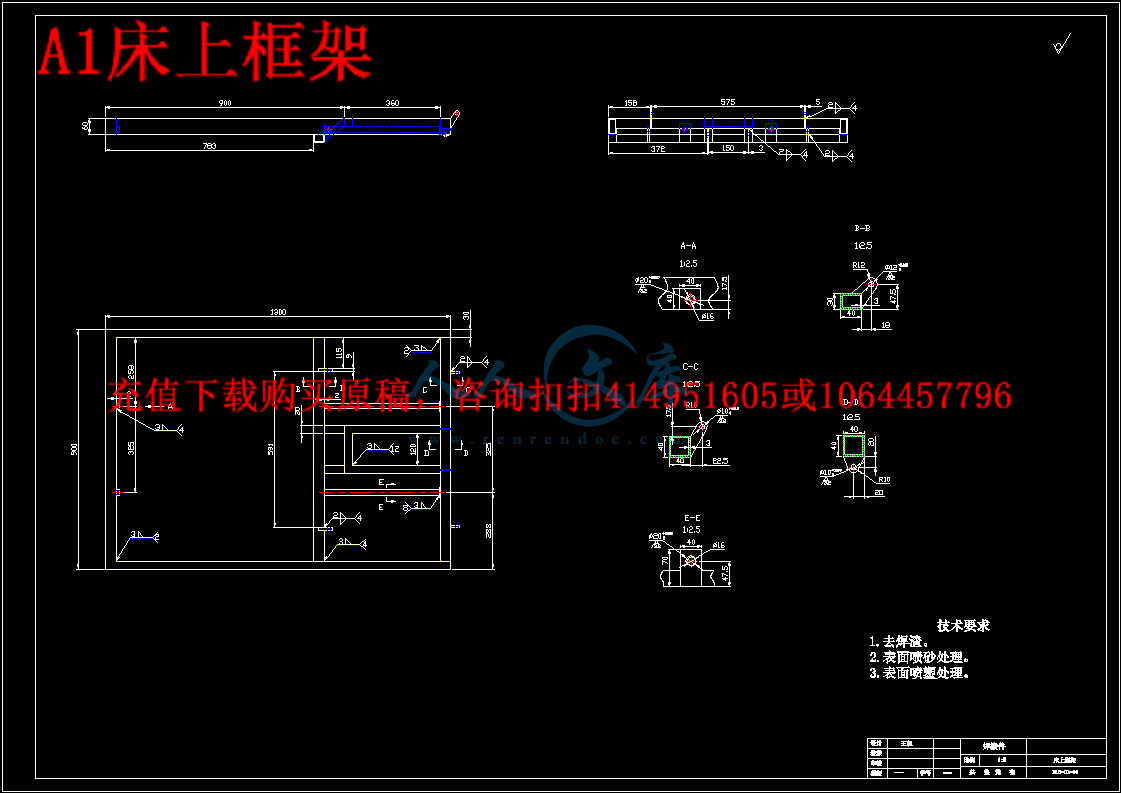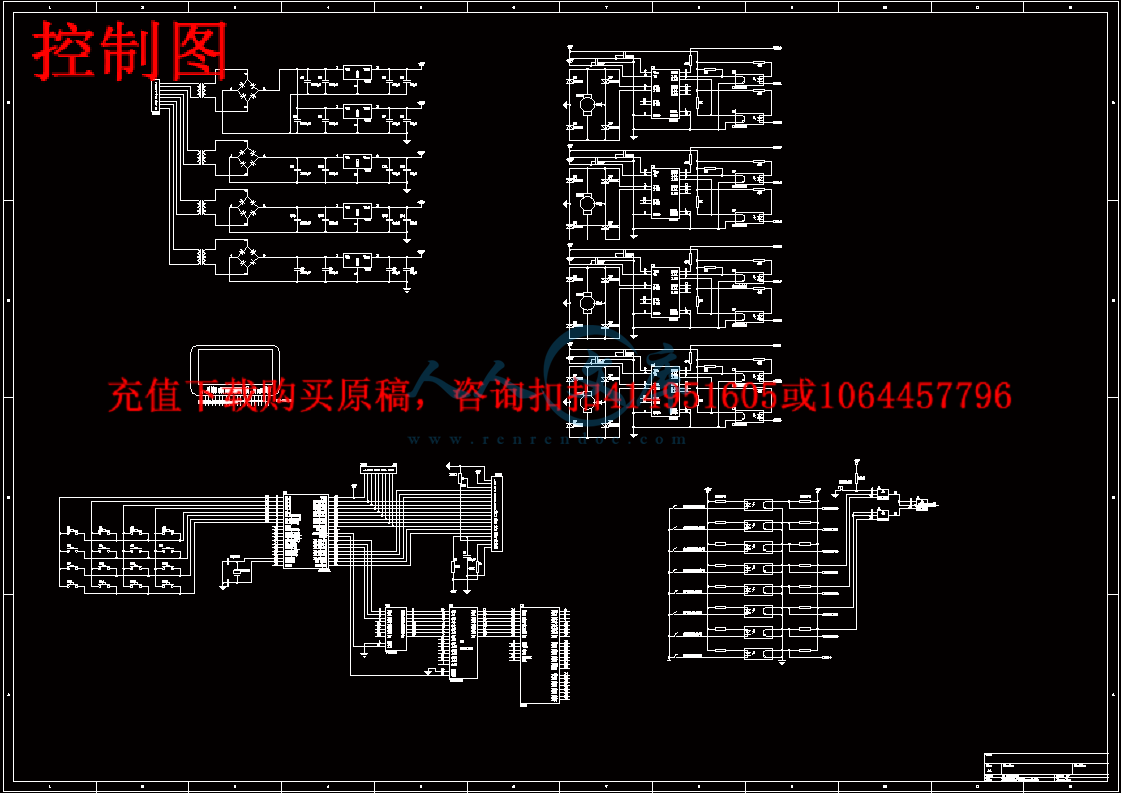【温馨提示】 购买原稿文件请充值后自助下载。
以下预览截图到的都有源文件,图纸是CAD,文档是WORD,下载后即可获得。
预览截图请勿抄袭,原稿文件完整清晰,无水印,可编辑。
有疑问可以咨询QQ:414951605或1304139763
摘 要
多功能医用护理床是一种针对危重病人和瘫痪病人的特殊需要而设计的,能随意调节床的背部和脚部的角度。即使不能自理者,护理人员也可通过床边的控制器进行操作,减少照顾病、残患者的劳动强度。本文针对上述情况,提出了一种新型的多功能医用护理床,采用三维数字化设计软件soliderworks对其进行建模和装配,然后导出到CAD进行修改。利用机械分析软件ADAMS对其进行运动学及动力学分析,研究了床板在各种运动状况下的角加速度对患者舒适度的影响及线性推杆在各姿态下的受力状况,并利用ADAMS提供的优化功能对其分别进行了运动学和动力学优化;以角加速度最大值的最小化作为优化目标函数进行运动学优化,以线性推杆受力的最大值最小化作为动力学优化目标函数,得到满足设计要求的机构参数。采用力学理论分别对多功能医用护理床的主要零件进行力学计算,保证了机构运动的安全性及稳定性。控制系统采用单片机控制,通过单片机控制,实现各个机构的运动,安装传感器来控制机构所转过的角度。利用单片机为主的控制系统,达到控制要求。
关键词:多功能医用护理床,干涉检验,运动学优化,动力学优化,控制系统
ABSTRACT
Multifunction Nursing-bed is designed for those critically ill patients and the special needs of paralyzed patients designed bed is able to adjust the angle of the back and feet. Even if we can not take care of themselves, the nursing staff can also be operated bedside controller to reduce the care of sick and disabled patients with the labor intensity. In this paper, the above situation, a new type of multi-functional medical care beds, the use of digital three-dimensional design software for modeling and soliderworks its assembly, then export to CAD and correct it. the mechanical analysis software ADAMS kinematics and dynamics of its analysis, research of the bed board in the under a wide variety of sports on the angular acceleration of the impact of patient comfort and linear putter in the posture of the force, and provided the use of optimization ADAMS conducted its kinematic and dynamic optimization; to angular acceleration The minimum value of objective function as for kinematic optimization, linear putting maximum stress as a dynamic optimization to minimize the objective function. Have to meet the design requirements of the body parameters. Finite calibration methods of mechanics of materials, respectively, of multi-bed medical care for the mechanical parts of the main check to ensure the safety of the movement and stability. Control system adopts microcomputer control, through MCU control, to achieve the movement of various agencies, to install sensors to control the body turn angle. Use of microcomputer-based control system to control demand.
Key words: Multifunction Nursing-bed, interfere check, kinematics optimization, dynamics optimization, control system
目录
1 绪论1
1.1 课题的目的及意义1
1.2 国内外研究状况及发展趋势1
1.3 本文主要研究内容6
1.4 本章小结6
2 护理床结构的整体方案7
2.1 护理要求7
2.2 护理床的总体方案构思7
2.3 本章小结9
3 护理床的结构设计10
3.1 引言10
3.2 侧翻机构10
3.3 抬背机构11
3.4 曲腿机构13
3.5护理床的三维建模14
3.6 本章小结16
4 护理床运动学优化17
4.1 引言17
4.2侧翻机构的运动学分析17
4.3抬背机构的运动学分析23
4.4曲腿机构的运动学分析26
4.5本章小结29
5 护理床动力学优化30
5.1引言30
5.2侧翻机构动力学分析30
5.3抬背机构动力学分析32
5.4曲腿机构动力学分析34
5.5本章小结36
6 护理床的力学分析37
6.1 引言37
6.2 力学计算37
6.3 本章小结40
7 护理床控制系统设计41
7.1 引言41
7.2 直流电机控制原理41
7.3 控制系统方案41
7.4 控制系统的硬件设计43
7.5 控制系统的软件设计48
7.6 本章小结52
8 结论53
8.1 课题结论53
8.2课题展望53
参考文献54
致谢56
1 绪论
1.1 课题的目的及意义
多功能医用护理床是针对生活不能自理的病人、危重病人和瘫痪病人的特殊需要而设计的,能随意调节床的背部和脚部的角度。即使不能自理者,护理人员也可通过床边的控制器进行操作,减少照顾病、残患者的劳动强度。课题根据国家和上海市中长期发展纲要确定的研究方向和企业的具体需要,设计一种用于医院重症病人用的多功能床,解决病人身体和生理方面的需要(抬背、翻身等),也减轻护理人员的劳动强度。针对市场需求开发设计一种结构简单、工作可靠、使用方便的多功能护理床并进行动态仿真,对于产品的产业化具有重要的意义。











 川公网安备: 51019002004831号
川公网安备: 51019002004831号